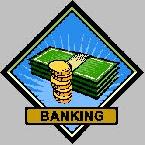
 |
|
| Financial Terms | |
| Policy Acquisition Costs |
|
Information about financial, finance, business, accounting, payroll, inventory, investment, money, inventory control, stock trading, financial advisor, tax advisor, credit.
Main Page: financial advisor, business, finance, credit, tax advisor, money, stock trading, financial, |
Definition of Policy Acquisition Costs
Policy Acquisition Costscosts incurred by insurance companies in signing new policies, including expenditures on commissions and other selling expenses, promotion expenses, premium
Related Terms:Acquisition of assetsA merger or consolidation in which an acquirer purchases the selling firm's assets. Acquisition of stockA merger or consolidation in which an acquirer purchases the acquiree's stock. Agency costsThe incremental costs of having an agent make decisions for a principal. Carring costscosts that increase with increases in the level of investment in current assets. Collection policyProcedures followed by a firm in attempting to collect accounts receivables. Corporate acquisitionThe acquisition of one firm by anther firm. Dividend policyAn established guide for the firm to determine the amount of money it will pay as dividends.  Execution costsThe difference between the execution price of a security and the price that would have Financial distress costsLegal and administrative costs of liquidation or reorganization. Also includes Fiscal policyThe use of government spending and taxing for the specific purpose of stabilizing the economy. Friction costscosts, both implied and direct, associated with a transaction. Such costs include time, effort, Horizontal acquisitionMerger between two companies producing similar goods or services. Incremental costs and benefitscosts and benefits that would occur if a particular course of action were Information costsTransaction costs that include the assessment of the investment merits of a financial asset. Market impact costsAlso called price impact costs, the result of a bid/ask spread and a dealer's price concession. Market timing costscosts that arise from price movement of the stock during the time of the transaction  Monetary policyActions taken by the Board of Governors of the Federal Reserve System to influence the Opportunity costsThe difference in the performance of an actual investment and a desired investment Perfect market view (of dividend policy)Analysis of a decision on dividend policy, in a perfect capital Policy asset allocationA long-term asset allocation method, in which the investor seeks to assess an Price impact costsRelated: market impact costs Round-trip transactions costscosts of completing a transaction, including commissions, market impact Search costscosts associated with locating a counterparty to a trade, including explicit costs (such as Signaling view (on dividend policy)The argument that dividend changes are important signals to investors Sunk costscosts that have been incurred and cannot be reversed. Tax differential view ( of dividend policy)The view that shareholders prefer capital gains over dividends, Tax free acquisitionA merger or consolidation in which 1) the acquirer's tax basis in each asset whose Taxable acquisitionA merger or consolidation that is not a tax-fee acquisition. The selling shareholders are Trading costscosts of buying and selling marketable securities and borrowing. Trading costs include Traditional view (of dividend policy)An argument that "within reason," investors prefer large dividends to Transactions costsThe time, effort, and money necessary, including such things as commission fees and the Variable life insurance policyA whole life insurance policy that provides a death benefit dependent on the Vertical acquisitionacquisition in which the acquired firm and the acquiring firm are at different steps in the Avoidable costscosts that are identifiable with and able to be influenced by decisions made at the business Direct costscosts that are readily traceable to particular products or services. Fixed costscosts that do not change with increases or decreases in the volume of goods or services Indirect costscosts that are necessary to produce a product/service but are not readily traceable to particular products or services – see overhead. Period costsThe costs that relate to a period of time. Semi-fixed costs costs that are constant within a defined level of activity but that can increase or decrease when Semi-variable costscosts that have both fixed and variable components. Standard costsA budget cost for materials and labour used for decision-making, usually expressed as a per unit cost that is applied to standard quantities from a bill of materials and to standard times from a Sunk costscosts that have been incurred in the past. capitalization of costsWhen a cost is recorded originally as an increase fixed expenses (costs)Expenses or costs that remain the same in amount, overhead costsOverhead generally refers to indirect, in contrast to direct, acquisitionTakeover of a firm by purchase of that firm’s common carrying costscosts of maintaining current assets, including opportunity cost of capital. collection policyProcedures to collect and monitor receivables. costs of financial distresscosts arising from bankruptcy or distorted business decisions before bankruptcy. credit policyStandards set to determine the amount and nature of credit to extend to customers. fixed costscosts that do not depend on the level of output. shortage costscosts incurred from shortages in current assets. sunk costscosts that have been incurred and cannot be recovered. variable costscosts that change as the level of output changes. Accomodating PolicyA monetary policy of matching wage and price increases with money supply increases so that the real money supply does not fall and push the economy into recession. Beggar-My-Neighbor PolicyA policy designed to increase an economy's prosperity at the expense of another country's prosperity. Cold-Turkey PolicyDecreasing inflation by immediately decreasing the money growth rate to a new, low rate. Contrast with gradualism. Demand Management PolicyFiscal or monetary policy designed to influence aggregate demand for goods and services. Discretionary PolicyA policy that is a conscious, considered response to each situation as it arises. Contrast with policy rule. Fiscal PolicyA change in government spending or taxing, designed to influence economic activity. Incomes PolicyA policy designed to lower inflation without reducing aggregate demand. Wage/price controls are an example. Menu CostsThe costs to firms of changing their prices. Monetary PolicyActions taken by the central bank to change the supply of money and the interest rate and thereby affect economic activity. Policy-Ineffectiveness PropositionTheory that anticipated policy has no effect on output. Policy RuleA formula for determining policy. Contrast with discretionary policy. Tax-Related Incomes Policy (TIP)Tax incentives for labor and business to induce them to conform to wage/price guidelines. Costs Capitalized in StealthA particularly egregious form of aggressive cost capitalization Creative Acquisition AccountingThe allocation to expense of a greater portion of the price Political CostsThe costs of additional regulation, including higher taxes, borne by large and Preopening CostsA form of start-up cost incurred in preparing for the opening of a new store or facility. Start-up Costscosts related to such onetime activities as opening a new facility, introducing Delivery policyA company’s stated goal for how soon a customer order will be Policy FeeThis is an administrative fee which is part of most life insurance policies. It ranges from about $40 to as much as $100 per year per policy. It is not a separate fee. It is incorporated in the regular monthly, quarterly, semi-annual or annual payment that you make for your policy. Knowing about this hidden fee is important because some insurance companies offer a policy fee discount on additional policies purchased under certain conditions. Sometimes they reduce the policy fee or waive it altogether on one or more additional policies purchased at the same time and billed to the same address. The rules are slightly different depending on the insurance company. There could be enormous savings if several people in the same family or business were intending to purchase coverage at the same time. PolicyholderThis is the person who owns a life insurance policy. This is usually the insured person, but it may also be a relative of the insured, a partnership or a corporation. There are instances in marriage breakup (or relationship breakup with dependent children) where appropriate life insurance on the support provider, owned and paid for by the ex-spouse receiving the support is an acceptable method of ensuring future security. Company AcquisitionsAssets acquired to create money. May include plant, machinery and equipment, shares of another company etc. Funding CostsThe price of obtaining capital, either borrowed or equity, with intent to carry on business operations. Lending PolicyA course of action adopted by a financial institution to guide and usually determine present and future decisions in the light of given conditions. Undepreciated Capital CostsThe tax definition of the value of an asset that is eligible for tax deprecation. Dividend PolicyThis policy governs Canada Life's actions regarding distribution of dividends to policyholders. It's goal is to achieve a dividend distribution that is equitable and timely, and which gives full recognition of the need to ensure the ongoing solidity of the company. It also specifies that distribution to individual policyholders must be equitable between dividend classes and policyholder generations, and among policyholders within any class. Insurance Policy (Credit Insurance)A policy under which the insurance company promises to pay a benefit of the person who is insured. Joint Policy LifeOne insurance policy that covers two lives, and generally provides for payment at the time of the first insured's death. It could also be structured to pay on second death basis for estate planning purposes. Non-participating PolicyA type of insurance policy or annuity in which the owner does not receive dividends. Participating PolicyA policy offers the potential of sharing in the success of an insurance company through the receipt of dividends. PolicyA written document that serves as evidence of insurance coverage and contains pertinent information about the benefits, coverage and owner, as well as its associated directives and obligations. Policy AnniversaryYearly event linked to a policy. Usually the date issued. Policy DateDate on which the insurance company assumes responsibilities for the obligations outlined in a policy. Policy FeeAdministrative charge included in a policy Premium. Policy YearPeriod between two policy anniversaries. PolicyownerThe person who owns and holds all rights under the policy, including the power to name and change beneficiaries, make a policy loan, assign the policy to a financial institution as collateral for a loan, withdraw funds or surrender the policy. Related to : financial, finance, business, accounting, payroll, inventory, investment, money, inventory control, stock trading, financial advisor, tax advisor, credit. |